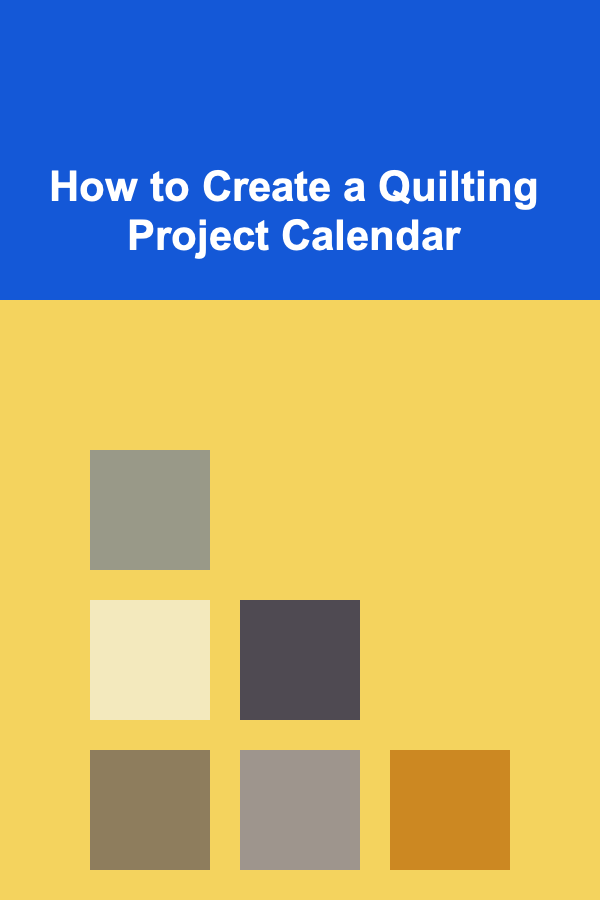
How to Create a Quilting Project Calendar
ebook include PDF & Audio bundle (Micro Guide)
$12.99$8.99
Limited Time Offer! Order within the next:

Creating a quilting project calendar is an essential tool for quilters who want to stay organized, meet deadlines, and keep their creative momentum flowing. A quilting calendar helps you break down large projects into smaller, more manageable tasks, ensuring that you can complete each step efficiently without feeling overwhelmed. In this guide, we will walk you through the process of creating a quilting project calendar that works for you, whether you're a beginner or an experienced quilter.
Why You Need a Quilting Project Calendar
A quilting project calendar offers numerous benefits, including:
- Organization: Helps you break down a large quilting project into smaller, actionable steps.
- Time Management: Ensures that you allocate enough time for each stage of the quilting process.
- Reduced Stress: Prevents procrastination by giving you a clear timeline for each task.
- Tracking Progress: Allows you to visually track your progress and stay motivated.
- Avoids Overwhelm: Breaks the project into smaller, manageable tasks, making it less likely for you to feel overwhelmed.
By creating a quilting project calendar, you can ensure that you not only finish your quilts on time but also enjoy the process. So let's dive into how to create your personalized quilting project calendar.
Step 1: Define Your Quilting Project
The first step in creating a quilting project calendar is to define the scope of your project. Whether you're making a large bed quilt, a table runner, or a wall hanging, it's essential to know what you're working on before you create a timeline.
Key Questions to Consider:
- What is the project type? Is it a traditional quilt, modern quilt, or something more experimental?
- What is the size of the quilt? The larger the quilt, the more time it will take to complete.
- What is your deadline? Do you need to finish by a specific date (e.g., a birthday, a holiday, a wedding)?
- What is your skill level? Are you a beginner or an experienced quilter? This will determine how much time you need for each step.
Example Project:
Let's say you want to make a king-size quilt with a simple patchwork design, and your deadline is a family reunion in six months.
Step 2: Break Down the Project Into Phases
Once you have a clear idea of your project, the next step is to break it down into phases. Quilting involves several stages, and dividing these stages into manageable parts will make your project seem less daunting.
Phases of a Quilting Project:
- Planning and Design: Deciding on the quilt pattern, choosing fabric, and sketching the design.
- Cutting the Fabric: Prepping and cutting all the fabric pieces needed for your quilt top.
- Piecing the Quilt Top: Sewing the fabric pieces together to create the quilt top.
- Preparing the Quilt Sandwich: Layering the quilt top, batting, and backing fabric.
- Quilting: The process of stitching through all three layers (top, batting, and backing).
- Binding: Adding the final touch with the quilt binding to finish the edges.
- Finishing Touches: Ironing, labeling, and any additional steps such as adding embellishments.
Example Breakdown:
For a king-size quilt with a patchwork design, the breakdown might look something like this:
- Phase 1 (Planning & Design): 1 week
- Phase 2 (Cutting the Fabric): 2 weeks
- Phase 3 (Piecing the Quilt Top): 3 weeks
- Phase 4 (Preparing the Quilt Sandwich): 1 week
- Phase 5 (Quilting): 4 weeks
- Phase 6 (Binding): 1 week
- Phase 7 (Finishing Touches): 1 week
Step 3: Allocate Time for Each Phase
Once you've broken down the project into phases, the next step is to allocate a realistic time frame for each phase. Keep in mind your skill level, available time, and the complexity of the project.
Time Allocation:
- Beginner Quilter: A beginner quilter might need more time for each phase, especially when it comes to piecing the quilt top and learning quilting techniques.
- Experienced Quilter: An experienced quilter can likely complete the same tasks faster due to their knowledge of techniques and efficiency with their tools.
It's also essential to add a buffer for any unexpected delays, such as fabric shortages, family commitments, or mistakes that need to be fixed.
Example Time Allocation:
- Phase 1 (Planning & Design): 1 week
- Phase 2 (Cutting the Fabric): 2 weeks
- Phase 3 (Piecing the Quilt Top): 3 weeks
- Phase 4 (Preparing the Quilt Sandwich): 1 week
- Phase 5 (Quilting): 4 weeks
- Phase 6 (Binding): 1 week
- Phase 7 (Finishing Touches): 1 week
Total: 13 weeks (3 months)
Step 4: Create a Detailed Timeline
Now that you have an idea of how long each phase will take, it's time to create a detailed timeline. A timeline will help you visualize your project's progress and ensure that you stay on track. You can create a timeline using a physical calendar, a spreadsheet, or a project management tool.
Using a Physical Calendar:
Write the dates of each phase and subtask on a physical calendar. For example:
- Phase 1 (Planning & Design): Week 1
- Phase 2 (Cutting the Fabric): Week 2--3
- Phase 3 (Piecing the Quilt Top): Week 4--6
- Phase 4 (Preparing the Quilt Sandwich): Week 7
- Phase 5 (Quilting): Week 8--11
- Phase 6 (Binding): Week 12
- Phase 7 (Finishing Touches): Week 13
Using a Spreadsheet:
You can also use a spreadsheet to map out your project's timeline. Each row would represent a task, with columns for dates, hours, and progress status.
| Task | Start Date | End Date | Progress Status | |------------------------------|------------|----------|-----------------| | Planning & Design | Jan 1 | Jan 7 | Completed | | Cutting the Fabric | Jan 8 | Jan 21 | In Progress | | Piecing the Quilt Top | Jan 22 | Feb 11 | Not Started | | Preparing the Quilt Sandwich | Feb 12 | Feb 18 | Not Started | | Quilting | Feb 19 | Mar 18 | Not Started | | Binding | Mar 19 | Mar 25 | Not Started | | Finishing Touches | Mar 26 | Apr 2 | Not Started |
Using Project Management Tools:
Digital tools like Trello, Asana, or Monday.com allow you to create a visual timeline, assign due dates, and track progress. You can set reminders for upcoming tasks and collaborate with others if you're working in a quilting group.
Step 5: Set Milestones and Deadlines
Setting milestones within each phase of your project will help you stay on track and motivated. These milestones can be small tasks that lead up to the completion of the larger phase.
For example, within the Piecing the Quilt Top phase, you could set milestones like:
- Completing the first row of patchwork.
- Assembling half of the quilt top.
- Attaching the quilt top to the backing.
Milestones make the project feel more achievable and can give you a sense of accomplishment as you move from one stage to the next.
Example Milestones for Piecing the Quilt Top:
- Milestone 1: Cut all fabric pieces (Jan 22--Jan 24).
- Milestone 2: Complete first row of piecing (Jan 25--Jan 30).
- Milestone 3: Complete half of the quilt top (Feb 3).
- Milestone 4: Complete the quilt top (Feb 11).
Step 6: Plan for Flexibility
Life happens, and unexpected events may delay your quilting project. It's crucial to allow some flexibility in your calendar to accommodate delays and avoid stress. By planning buffer time between phases or tasks, you can give yourself the freedom to adjust your schedule as needed.
For example:
- Buffer Time: Add one or two extra days at the end of each phase for unforeseen delays.
- Flexible Timeline: If you find yourself getting behind schedule, be prepared to extend your deadlines for the non-urgent phases of the project.
Step 7: Track Your Progress
Tracking your progress is an essential step in maintaining your quilting project calendar. Not only does it help you stay on track, but it also allows you to identify areas where you may need more time or adjustments.
How to Track Progress:
- Keep a journal or a digital log of each task as you complete it.
- Mark milestones when they are achieved to stay motivated.
- Adjust your calendar if unexpected challenges arise.
Step 8: Celebrate Your Accomplishments
Once you've completed your quilting project, take a moment to celebrate! Whether it's finishing a quilt for yourself or gifting it to someone else, accomplishing your goal is something to be proud of. Take a photo of your finished project, share it with fellow quilters, and bask in the satisfaction of your hard work.
Conclusion
Creating a quilting project calendar is an effective way to stay organized, reduce stress, and ensure that you complete your projects on time. By defining your project, breaking it into manageable phases, and setting deadlines and milestones, you can make the process of quilting more enjoyable and rewarding. Whether you're working on a simple quilt or a complex masterpiece, a calendar will help you track your progress and ensure that you finish each project with pride.
Happy quilting!
Reading More From Our Other Websites
- [Organization Tip 101] How to Prepare a First Aid Kit for Your Travels
- [Home Family Activity 101] How to Create a Family Holiday Tradition for Every Season
- [Scrapbooking Tip 101] Creative Layout Ideas for Your Holiday Travel Journal
- [Personal Care Tips 101] How to Apply Toner with a Cotton Pad vs. Your Hands
- [Home Budget Decorating 101] How to Make Your Home Look Expensive with Simple DIY Projects
- [Personal Investment 101] How to Use Deep Learning Models to Generate Passive Income
- [Home Renovating 101] How to Turn Your Attic into a Functional and Cozy Space
- [Biking 101] How to Choose the Best Bike Grips for Comfort and Control
- [Toy Making Tip 101] From Playroom to Workshop: How Toy Making Became My Favorite Hobby
- [Home Lighting 101] How to Choose the Right Lighting for Your Dining Room

How to Create a Pet-Friendly Home Office Space
Read More
How to Onboard International Employees Successfully
Read More
How to Store Shoes in Small Spaces Without Cluttering
Read More
The Ultimate Guide to Saving Money on Household Cleaning Supplies
Read More
How to Choose the Right Coffee Beans for Your Taste
Read More
Understanding Decentralized Applications (DApps): A Deep Dive
Read MoreOther Products

How to Create a Pet-Friendly Home Office Space
Read More
How to Onboard International Employees Successfully
Read More
How to Store Shoes in Small Spaces Without Cluttering
Read More
The Ultimate Guide to Saving Money on Household Cleaning Supplies
Read More
How to Choose the Right Coffee Beans for Your Taste
Read More